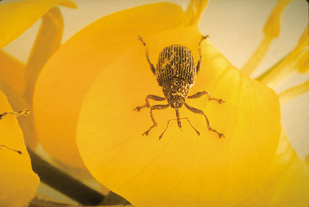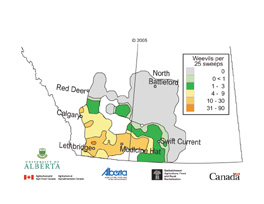
Features
Agronomy
Insect Pests
Cabbage seedpod weevil update
Cabbage seedpod weevil continues its slow spread across the prairies.
November 29, 2007 By Bruce Barker
Cabbage seedpod weevil continues its slow spread across the prairies. With
a range that extends throughout southern Alberta and into central Saskatchewan,
scientists believe that it will eventually spread across the prairies. However,
while the 2005 data has not been completely analyzed, it appears that the weevil
infestation in 2005 was not as bad as anticipated.
"All the indicators from last fall showed that we were in for an increase
in 2005," says Lloyd Dosdall, associate professor of agricultural entomology
at the University of Alberta in Edmonton. "From what we saw last fall,
I had thought the outbreak would have been more substantial than it was."
Dosdall says that based on the emergence of a new generation of cabbage seedpod
weevil adults from canola stubble late in 2004, the southern Alberta outbreak
should have been higher. Emergence traps set in canola stubble near Lethbridge
routinely collected 200 to 300 adults per square metre, a level comparable to
that which preceded previous outbreaks. He is not sure why the lower 2005 infestation
level, but suspects spring 2005 weather had something to do with the lower than
anticipated outbreak.
Certainly, some fields were severely infested in 2005, with 25 to 30 weevils
per single sweep sample. Those fields were mainly in the Lethbridge area where
a fair amount of spraying was conducted. The economic threshold, where insecticidal
spraying is warranted, has been established at three to four adult weevils per
sweep during the bud to flowering stage. The northern limit of the outbreak,
where spraying was required, appeared to be around Vulcan and Brooks, Alberta.
Still, Dosdall says that the population did advance northward and continues
to spread and build-up.
 |
| A cabbage seedpod weevil adult. Photo courtesy of Lloyd Dosdall, AAFRD. |
While the infestation was not as bad as in the 1999 and 2000 outbreaks, predictive
models have shown that the weevil can survive across the prairies. Manitoba,
with its hot, humid weather, may be particularly favourable to the weevil, if
it arrives there.
Research focus on resistance and cultural controls
A large multi-disciplinary research project has been underway for several years
to develop an integrated pest management program for weevil control. The project
is funded by the Alberta Agricultural Research Institute, the Canola Council
of Canada, the canola producer commissions in Alberta, Saskatchewan and Manitoba,
and agribusiness. The components are looking at chemical control, host plant
resistance, cultural control, biological control and technology transfer.
Over the past four years, the project has worked towards incorporating cabbage
seedpod weevil resistance into canola from intergeneric crosses with Brassica
napus (Argentine canola) and Sinapis alba (yellow mustard). Hector
Carcamo, a research scientist with Agriculture and Agri-Food Canada (AAFC) at
Lethbridge, has been testing new germplasm from AAFC Saskatoon. The plants have
been tested in both greenhouses and field plots.
In testing the experimental lines, Carcamo says all of the Sinapis alba
lines had significantly fewer exit holes in the pods than the control Q2 variety.
The most resistant lines were approximately four times more resistant.
Dosdall says it is clear that resistant germplasm offers hope. The field testing
validates the potential. "In 2005, we worked on the mechanisms of resistance.
We were following the females and observing their activity before laying eggs.
The females make a hole in the pod, with their long snouts, and they seemed
to get their snout caught in the pod with the resistant germplasm."
Dosdall says that female weevils also seemed to slide off the resistant pods;
he is not sure of the reason. The larvae also do not develop properly inside
the pods of the resistant lines.
The next step is to develop molecular markers for the resistant genes. This
will help move the resistance into commercial lines. While the release of resistant
varieties is still three to four years down the road, it will be the best hope
for protection against the weevil.
Dosdall has also been looking at natural parasites of the cabbage seedpod weevil.
He saw a 50 fold increase in parasitoids over the last two years. "That
bodes well for natural control mechanisms."
At least 12 species of hymenopteran wasps are attacking weevil larvae within
canola pods. In areas where weevil has occurred for some time, parasitoids are
dominated by pteromalid, Trichomalus lucidus. In newer areas, such as
southwestern Saskatchewan, the dominant parasitoid is the eulophid, Necremnus
tidius.
Research has also shown that early seeding (late April) exposes the crop to
a higher risk of weevil attack. Delayed seeding is being assessed to see if
it offers an economical solution to managing the weevil.
| Figure 1: 2004 cabbage seedpod weevil survey. Source: AAFC. |
 |
At Lethbridge, Carcamo completed a project looking at the use of border trap
crops as a lure for the weevil, where it can then be targetted with insecticides.
He says that in larger fields, greater than 80 acres, trap cropping may offer
a partial solution. On fields of less than 80 acres, and irrigated fields, the
practice was not as beneficial when weevil populations were far above the economic
threshold.
Carcamo says that for a trap crop to be effective, farmers need to maximize
the window when only the trap crop is in bloom. The goal is to early seed a
trap crop so that it blooms at least five days before the main crop. The early
flowering area then attracts the weevils, where they are sprayed with an insecticide.
Polish-type canola can act as a trap crop and can be seeded on the same day
as the rest of the field, to minimize equipment moves in the spring. Early maturing
Argentine-type canola can also be seeded around the outside of the field as
a trap crop. The trap crop should be at least 80 feet wide around all sides
of the field. He is currently finalizing recommendations for trap cropping.
Carcamo also looked at the effectiveness of insecticides and found that under
field conditions, Decis and Matador 120EC (both pyrethroids) consistently reduced
weevil numbers, even at high populations. Chlorpyrifos (Lorsban, Pyrinex, Nufos)
also significantly reduced weevil numbers and damage in some years, but results
were variable and efficacy was too low to manage weevils under outbreak densities.
A concern of fence-post to fence-post applications of insecticides is the effect
on natural parasitoids. Carcamo says that further research is needed to assess
the effect of insecticides on non-target natural enemies of the cabbage seedpod
weevil, and to assess the integration of insecticides with biological and cultural
controls strategies.